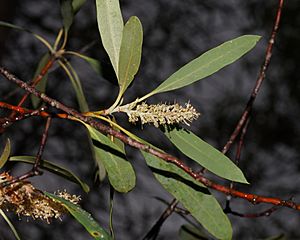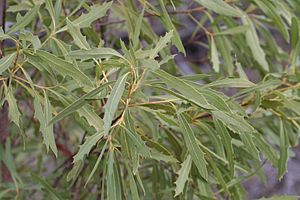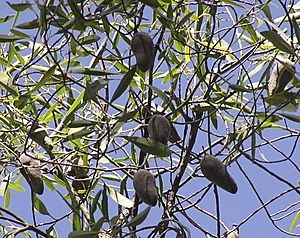Xylomelum cunninghamianum facts for kids
Quick facts for kids Xylomelum cunninghamianum |
|
|---|---|
 |
|
| Near Nandi | |
| Scientific classification | |
| Genus: |
Xylomelum
|
| Species: |
cunninghamianum
|
The Xylomelum cunninghamianum is a special type of flowering plant. It belongs to the Proteaceae plant family. This plant grows only in eastern Australia. It can be a bush or a small tree. Its leaves are long and narrow. Young leaves have small teeth along their edges. Its flowers grow in groups and have brownish hairs. The fruit is oval-shaped. It is covered with soft, rust-colored or grey hairs.
Contents
Discovering the Xylomelum cunninghamianum
This plant is usually a bush or a small tree. It can grow up to 12 meters (about 39 feet) tall. Its new parts are covered with short, brownish hairs.
Leaves and Flowers
The leaves are long and narrow. They are shaped like a spear tip. Each leaf is about 80 to 120 millimeters (3 to 4.7 inches) long. They are also 15 to 20 millimeters (0.6 to 0.8 inches) wide. Young leaves are a bit bigger. They can be 80 to 150 millimeters (3 to 5.9 inches) long. These young leaves have up to five large teeth on each side.
The flowers grow on spikes. These spikes are 30 to 40 millimeters (1.2 to 1.6 inches) long. Each flower is small, about 8 to 10 millimeters (0.3 to 0.4 inches) long. They are also covered with short brown hairs. This plant usually blooms from February to May.
Fruit and Seeds
After flowering, an oval-shaped fruit grows. This fruit is called a follicle. It is quite large, about 60 to 90 millimeters (2.4 to 3.5 inches) long. It is also 30 to 45 millimeters (1.2 to 1.8 inches) wide. The fruit is covered with soft, rust-colored or grey hairs. Inside the fruit are pale brown seeds. These seeds are long, about 59 to 70 millimeters (2.3 to 2.8 inches) long. They are also 15 to 20 millimeters (0.6 to 0.8 inches) wide.
How it's Different
The Xylomelum cunninghamianum is similar to another plant, X. pyriforme. However, X. cunninghamianum is generally bigger and stronger. It also has larger leaves, flowers, and fruits.
Naming and Classification
Every living thing has a scientific name. This helps scientists around the world know exactly which plant or animal they are talking about.
How it Got its Name
The Xylomelum cunninghamianum was first officially described in 1987. A scientist named Donald Bruce Foreman gave it its name. He wrote about it in a science journal called Muelleria. He found the plant near Wallangra in 1985. The second part of its name, cunninghamianum, honors Allan Cunningham. He was a famous botanist, a scientist who studies plants.
Where the Plant Lives
The Xylomelum cunninghamianum grows in forests and woodlands. It prefers sandy soil. You can find this plant in different places across eastern Australia. It grows from the Blackdown Tableland National Park in Queensland. It also grows down to the Coolatai-Wallangra area in New South Wales.



